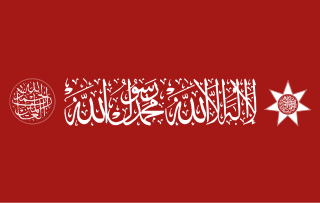
The Hashemites, also House of Hashim, are the royal family of Jordan, which they have ruled since 1921, and were the royal family of the kingdoms of Hejaz (1916–1925), Syria (1920), and Iraq (1921–1958). The family had ruled the city of Mecca continuously from the 10th century, frequently as vassals of outside powers, and ruled the thrones of the Hejaz, Syria, Iraq, and Jordan following their World War I alliance with the British Empire.
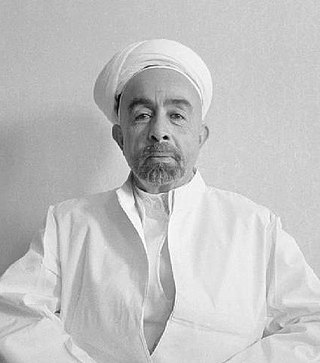
Abdullah I bin Al-Hussein was the ruler of Jordan from 11 April 1921 until his assassination in 1951. He was the Emir of Transjordan, a British protectorate, until 25 May 1946, after which he was king of an independent Jordan. As a member of the Hashemite dynasty, the royal family of Jordan since 1921, Abdullah was a 38th-generation direct descendant of Muhammad.

The House of Saud is the ruling royal family of Saudi Arabia. It is composed of the descendants of Muhammad bin Saud, founder of the Emirate of Diriyah, known as the First Saudi state (1727–1818), and his brothers, though the ruling faction of the family is primarily led by the descendants of Abdulaziz bin Abdul Rahman, the modern founder of Saudi Arabia. It forms a subtribe of the larger prominent ancient Banu Hanifa tribe of Arabia, from which well known 7th century Arabian theologist Maslama ibn Ḥabīb originates. The most influential position of the royal family is the King of Saudi Arabia, an absolute monarch. The family in total is estimated to comprise 15,000 members; however, the majority of power, influence and wealth is possessed by a group of about 2,000 of them. Some estimates of the royal family's wealth measure their net worth at $1.4 trillion.This figure includes the market capitalization of Saudi Aramco, the state oil and gas company, and its vast assets in fossil fuel reserves, making them the wealthiest family in the world and the wealthiest in recorded history.

Talal bin Abdullah was King of Jordan from the assassination of his father, King Abdullah I, on 20 July 1951 until his forced abdication on 11 August 1952. As a member of the Hashemite dynasty, the royal family of Jordan since 1921, Talal was a 39th-generation direct descendant of Muhammad.
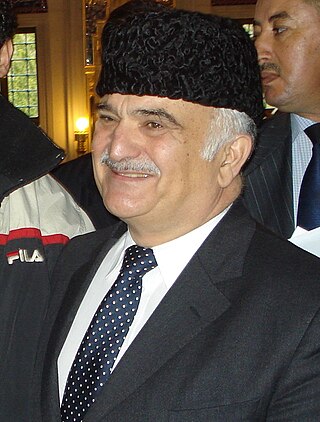
Prince El Hassan bin Talal is a member of the Jordanian royal family who was previously Crown Prince from 1965 to 1999, being removed just three weeks before King Hussein's death. He is now 20th in line to succeed his nephew King Abdullah II.

Hamzah bin Al Hussein, is the fourth son of King Hussein bin Talal of Jordan overall and the first by his American-born fourth wife, Queen Noor. He was named Crown Prince of Jordan in 7 February 1999, a position he held until his older half-brother, King Abdullah II, rescinded it in 28 November 2004. He is a member of the Hashemite dynasty, the royal family of Jordan since 1921, and is a 41st-generation direct descendant of Muhammad.

Ra'ad bin Zeid is the son of Prince Zeid of the Hashemite House and Princess Fahrelnissa Zeid, a Turkish noblewoman. His father died on October 18, 1970, leaving him in charge of the former Royal Houses of Iraq. Ra'ad has lived in London and Paris.
Prince Asem bin Nayef is the son of Prince Nayef bin Abdullah and Princess Mihrimah Sultan. It is claimed he is the 42nd generation direct descendant of Muhammad.
Princess Sana'a Asem is a Jordanian princess due to her marriage to Prince Asim bin Nayef and she has Circassian origin. She is the daughter of Adnan Mawloud Kalimat, leader of the Circassians tribal council of Jordan and mukhtar of the Circassians in the city of Amman.

Hussein bin Abdullah is Crown Prince of Jordan as the eldest son of King Abdullah II and Queen Rania. He is a member of the Hashemite dynasty, the royal family of Jordan since 1921, and is considered to be 42nd-generation direct descendant of the Islamic prophet Muhammad.

The order of succession to the Saudi Arabian throne is determined by, and within, the House of Saud. Every King of Saudi Arabia, upon his death, has been succeeded by the crown prince, with a new crown prince then being appointed according to agnatic seniority among the sons of Ibn Saud, though various members of the family have been bypassed for various reasons. A deputy crown prince was first selected in 2014.
Princess Noor bint Asem is a member of the Jordanian royal family.

Prince Muhammad bin Talal was a member of the Jordanian royal family. He was the second son of King Talal of Jordan and the younger brother of King Hussein of Jordan. He was heir-presumptive to the throne from his elder brother's accession in 1952, until the birth of his nephew (Abdullah) in 1962.

The Order of the Star of Jordan or The Order of Hussein ibn Ali is an award and order of Jordan and is awarded for military or civil merit.

The Allegiance Council, also known as the Allegiance Commission or Allegiance Institution or Succession Commission, is the body responsible for determining future succession to the throne of Saudi Arabia. It was formed on 7 December 2007 by King Abdullah. At the time of its formation, the Council's intended function was to appoint a Crown Prince once a new King succeeds to the throne.
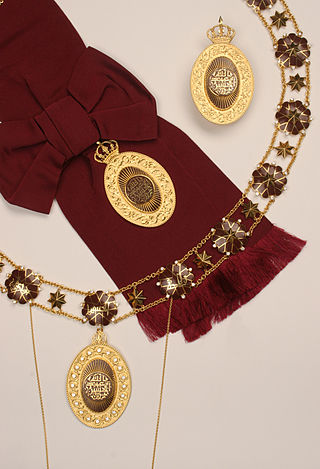
The Order of al-Hussein bin Ali is the highest order of the Kingdom of Jordan. It was founded on 22 June 1949 with one class by King Abdullah I of Jordan with the intended recipients being foreign heads of state and senior royals.
Mihrimah Sultan was an Ottoman princess, the daughter of Şehzade Mehmed Ziyaeddin, son of Mehmed V. She was a Jordanian princess as wife of Prince Nayef bin Abdullah, the son of Abdullah I of Jordan, emir of Emirate of Transjordan.
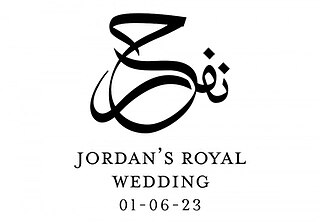
The wedding of Al Hussein bin Abdullah, Crown Prince of Jordan, and Rajwa Al Saif took place at Zahran Palace in Amman, Jordan on 1 June 2023.













